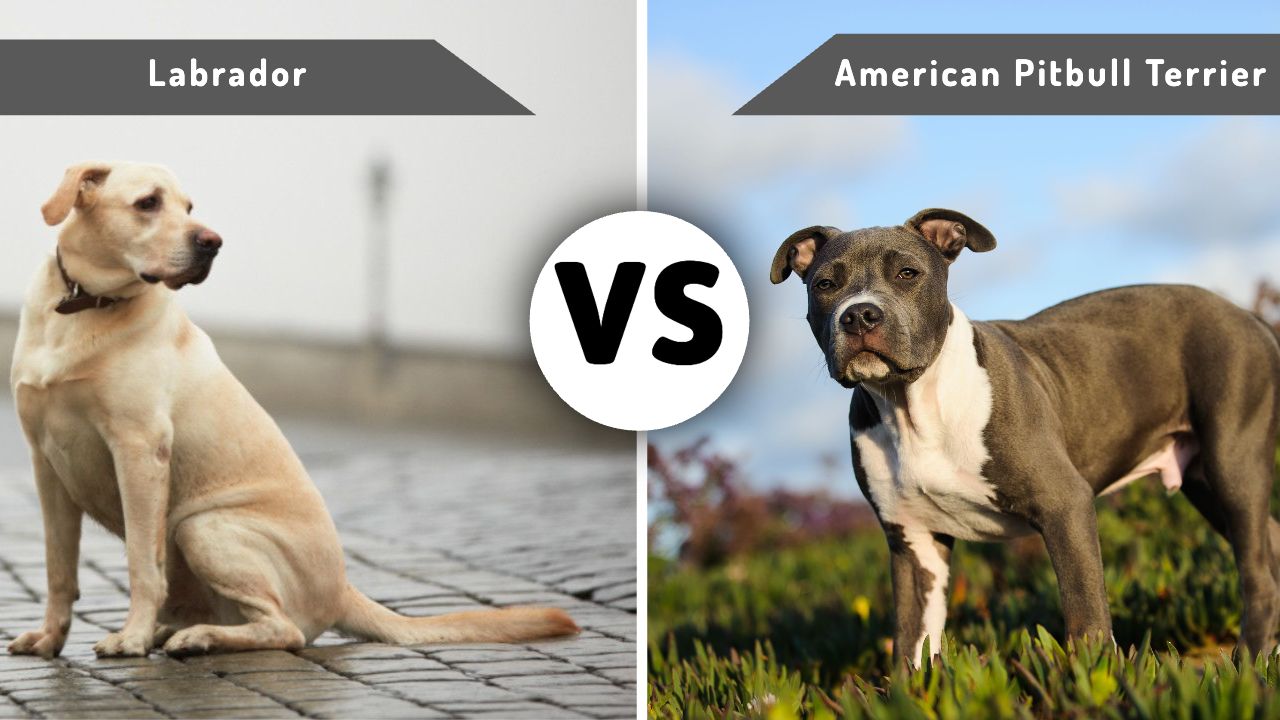
Are you trying to decide whether to bring a Labrador Retriever or a Pitbull home? Both breeds have a lot to offer prospective dog owners, but there are also some critical differences you need to know before making your final decision.
In this breed comparison article, we’ll take a close look at the Labrador Retriever and the Pitbull, covering everything from their history and temperament to exercise needs and health concerns. By the end, you will have a pretty good idea of which breed is the better fit for you and your family.
So, without further ado, let’s dive in!
| BREED COMPARISON | ||
|---|---|---|
| Labrador Retriever | American Pit Bull Terrier | |
| Weight | 55 to 80 pounds | 30 to 60 pounds |
| Height | 21.5 to 24.5 inches | 17 to 21 inches |
| Size | Medium-sized dogs | Medium-sized dogs |
| Temperament | Outgoing, Friendly, Intelligent | Friendly, Loyal, Confident |
| Trainability | 5.0 out of 5.0 stars5.0 | 4.0 out of 5.0 stars4.0 |
| Energy Level | 5.0 out of 5.0 stars5.0 | 4.0 out of 5.0 stars4.0 |
| Life Expectancy | 11-13 years | 10-12 years |
| Shedding | Moderate | Low |
| Hypoallergenic | No | No |
| Puppy Costs | $1,000 to $2,500 | $1,000 to $5,000 |
| Takeaways | Labrador Retrievers have an outgoing personality. They love being outdoors and have a lot of energy, making them an excellent choice for someone who lives an active lifestyle. They are also very friendly and good with children. So if you have kids, a Lab would be a great option. | American Pit Bull Terriers (APBTs) get along well with children, other dogs, and strangers and are exceptionally friendly if properly socialized. They are intelligent and highly trainable but can be a bit strong-willed sometimes, so patience and consistency are key when training them. They are also very loyal and will do anything to protect their family if they sense immediate danger. |
Breed History & Origin
Many people think the Labrador Retriever was developed in Labrador, but the breed actually originated in Newfoundland. These pups were initially bred to help fishermen haul in their catch and retrieve nets and lines in the 1500s. Labs eventually made their way to England in the 1800s and quickly became popular with hunters. Recognized by the AKC in 1917, they are now one of the most popular breeds in the United States.
The Pitbull, also known as the APBT (American Pit Bull Terrier), on the other hand, has a bit of a controversial past. They were developed in England in the 19th century by crossbreeding Old English Bulldogs and Terriers. Bulldogs were popular back then for their use in bull-baiting, a bloodsport in which dogs were pitted against a chained bull. And when bull-baiting was eventually outlawed in 1835, Bulldogs were crossed with Terriers to create Pitbull Terriers for rat-baiting and dogfighting, contributing to the breed’s negative reputation today.
While the Pitbull’s original purpose was far from ideal, things have changed a lot since then, and Pitbulls are now much more likely to be found in loving homes than in fighting pits. However, they are still unfortunately discriminated against in many places and are often deemed dangerous.
Appearance
You can easily tell a Labrador Retriever and a Pitbull apart by their physical appearance and can spot the difference between these breeds from a mile away, even to the untrained eye.
Labrador Retrievers are medium-sized dogs, with males standing at 22.5-24.5 inches tall and females at 21.5-23.5 inches tall, on average. They weigh anywhere from 55 to 80 pounds when fully grown and have a short, dense coat that can be either black, chocolate, or yellow.
Pitbulls are shorter and stockier than Labrador Retrievers, with males averaging 18-21 inches tall and females 17-20 inches tall and can weigh 30 to 60 pounds when fully grown. They have a glossy and smooth but stiff-to-the-touch coat that can be any color (except merle), though the more common colors are black, white, fawn, buckskin, and red.
Temperament
Labrador Retrievers are known for being friendly, outgoing, and high-spirited. They are great with children and other dogs. They are also people-oriented and love nothing more than being around their favorite humans, making them excellent family pets. Also, it’s rare for a Lab to dislike strangers, as they are very trusting of people. And as such, they make terrible watchdogs and are not suited for guard dog duty.
On the other hand, Pitbulls have gotten a bit of a bad rap over the years. They are often seen as dangerous and aggressive, but this couldn’t be further from the truth. While Pitbulls were bred for fighting, they are not naturally aggressive dogs, and with proper socialization and training, they can be just as loving and friendly as any other breed of dog. They are also people-oriented, though they can be a bit more reserved around strangers than Labs. Additionally, they are incredibly loyal to their family and will do anything to protect them.
Exercise Needs
Labs and Pitbulls are both high-energy breeds that need a lot of exercises to stay happy and healthy.
Labrador Retrievers need at least an hour and a half to two hours of vigorous exercise daily, which can be in the form of a long walk, hike, or run alongside you or a bike. They also love to swim, so if you have access to a pool or lake, that’s even better. Additionally, Labs need lots of mental stimulation. So ensure to provide them with plenty of interactive games, puzzles, and training sessions to keep their mind sharp.
Pitbulls can get by with a bit less exercise than Labs. They generally only need an hour to an hour and a half of vigorous exercise daily. And as with all dogs, they will benefit from interactive games, fetch, and tug-of-war with their favorite humans.
Training
Both Labrador Retrievers and Pitbulls are intelligent breeds that are easy to train. Labs, in particular, are known for being one of the easiest dog breeds to train, thanks to their eagerness to please, hence why they are often used as service dogs.
Pitbulls are also highly trainable. They, too, are eager to please their humans and love nothing more than praises and a good belly rub after a job well done. However, they can be a bit more stubborn than Labs, meaning you’ll need to be more patient with them during training sessions. And be sure to socialize them early to ensure they grow up to be a good canine citizen.
Health
Labrador Retrievers have an average lifespan of 11-13 years, while Pitbulls live an average of 10-12 years. Both are relatively healthy breeds, but there are a few health conditions to be aware of.
Labrador Retrievers are predisposed to hip and elbow dysplasia, hypothyroidism, seizures, skin problems, and cancer. Pitbulls are susceptible to hip and elbow dysplasia, degenerative myelopathy, kneecap dislocation, and skin problems like allergies, hot spots, and dermatitis. They both are also prone to obesity. Labs, especially, are more likely to become overweight than Pits as they are very food motivated. So, it’s crucial to monitor their food intake.
The key to a healthy Lab or Pit is feeding them a high-quality diet, giving them enough exercise, and bringing them to the vet for regular checkups. Getting your canine’s bi-annual bloodwork done will also help you catch any potential health problems early on, giving them the best chance for a long and healthy life.
Nutrition & Diet
Labrador Retrievers and Pitbulls are both high-energy breeds that need a diet high in protein and fat to meet their energy needs. They also need fatty acids (omega-3 and omega-6) and vitamins and minerals to support their overall health.
A high-quality kibble or dry food will do the trick, as most brands these days are formulated to meet a dog’s nutritional needs. Just make sure to read the labels carefully and choose a food that is appropriate for your pup’s age and activity level. And be sure to avoid any foods high in fillers as they have little to no nutritional value for your pup.
When it comes to how much to feed your Lab or Pit, it depends on their age, activity level, and weight. Puppies, for example, need to eat more frequently than adults as they are still growing and developing. And active dogs will need more calories than sedentary ones. But as a general rule of thumb, an adult Lab needs 3 to 4 cups of food per day, while an adult Pitbull needs 2 to 3 cups.
Grooming Needs
Grooming a Pitbull is relatively easy as they have a short, single coat. They are considered a low-maintenance breed in this respect. That doesn’t mean they don’t need to be brushed, though it’s easy to assume that since their coat is short. Brushing them once a week will help to remove any dead hair and distribute their natural oils. Plus, brushing will make it easier to spot ticks.
On the other hand, Labrador Retrievers have a double coat with a softer, insulating undercoat and a waterproof outer coat. This helps to protect them from cold weather and water, but it also means they shed a lot more than Pits, and you’ll need to brush them more often. Once to two times a week at least, if not more, to help control the shedding. And be prepared for some extra vacuuming, especially during shedding season!
As for bathing, both breeds need to be bathed every four to six weeks or as needed. Make sure not to overdo it, as bathing too often can strip their natural oils from their skin, leaving them dry and irritated. They’ll also need their nails trimmed every two to four weeks, and their teeth should be brushed daily, ideally, or at least a few times a week.
Final Thoughts
So, which breed is right for you? Both are great dogs with a lot to offer, so it really comes down to personal preference in many respects.
One thing that I’ll say, though, is that if you’re looking for a couch potato, neither of these breeds is for you. Both Pits and Labs need plenty of exercises, so be prepared to take them on walks, runs, or hikes regularly. They both also need a fair amount of mental stimulation, so daily games of fetch or training sessions are a must.
If you are a first-time dog owner, I recommend a Labrador Retriever over a Pitbull. This is because they are more even-tempered and easier to train than Pits. However, that is not to say that Pits can’t make great family dogs – they absolutely can! It will just require a little more patience, consistency, and training on your part.
And if you plan to buy or adopt a Pit, do your research to see if it is banned in your area. Many municipalities have breed-specific legislation that prohibits or restricts ownership of Pitbulls. Also, some homeowners insurance companies may not cover you if you own one, or they may charge you higher rates. So that’s something to keep in mind as well.

